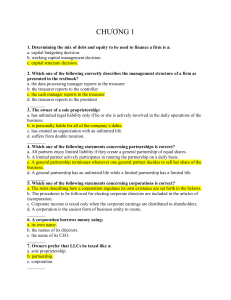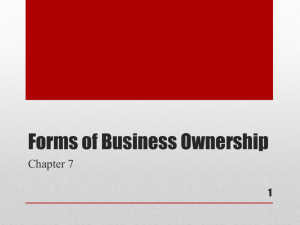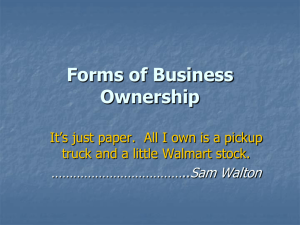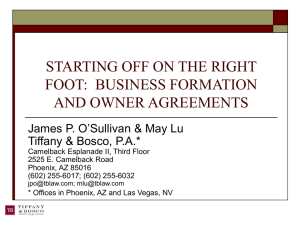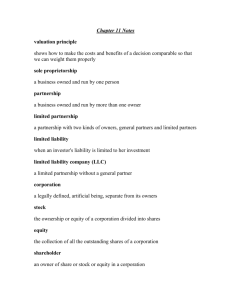Chapter 01 Quiz A
advertisement
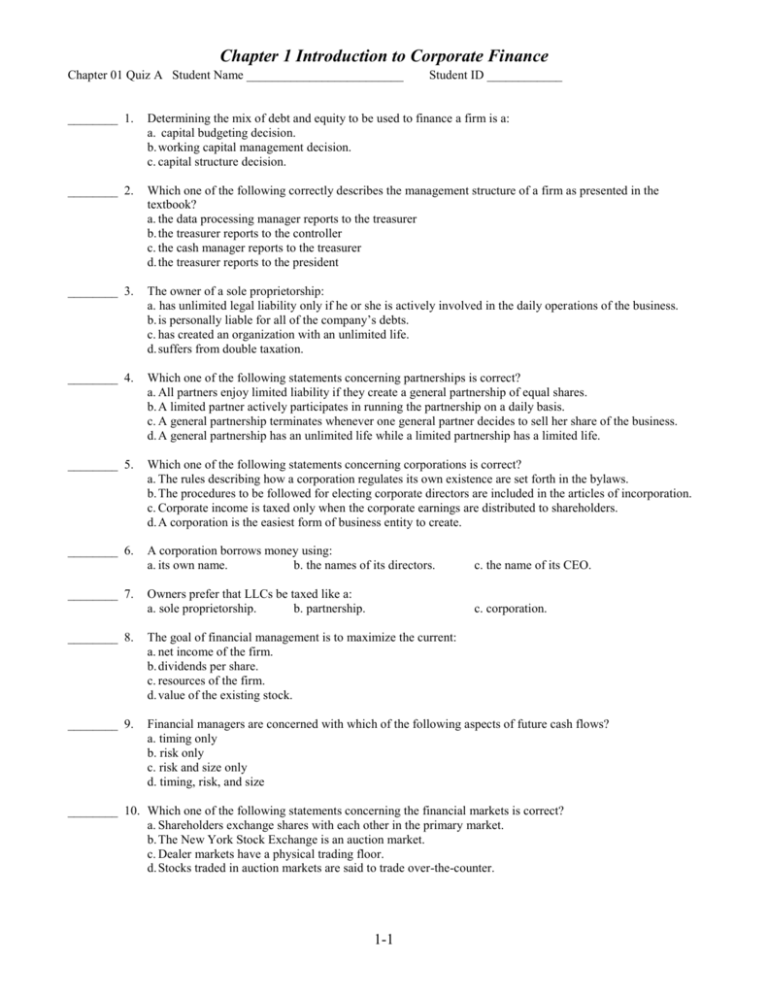
Chapter 1 Introduction to Corporate Finance Chapter 01 Quiz A Student Name _________________________ Student ID ____________ ________ 1. Determining the mix of debt and equity to be used to finance a firm is a: a. capital budgeting decision. b. working capital management decision. c. capital structure decision. ________ 2. Which one of the following correctly describes the management structure of a firm as presented in the textbook? a. the data processing manager reports to the treasurer b. the treasurer reports to the controller c. the cash manager reports to the treasurer d. the treasurer reports to the president ________ 3. The owner of a sole proprietorship: a. has unlimited legal liability only if he or she is actively involved in the daily operations of the business. b. is personally liable for all of the company’s debts. c. has created an organization with an unlimited life. d. suffers from double taxation. ________ 4. Which one of the following statements concerning partnerships is correct? a. All partners enjoy limited liability if they create a general partnership of equal shares. b. A limited partner actively participates in running the partnership on a daily basis. c. A general partnership terminates whenever one general partner decides to sell her share of the business. d. A general partnership has an unlimited life while a limited partnership has a limited life. ________ 5. Which one of the following statements concerning corporations is correct? a. The rules describing how a corporation regulates its own existence are set forth in the bylaws. b. The procedures to be followed for electing corporate directors are included in the articles of incorporation. c. Corporate income is taxed only when the corporate earnings are distributed to shareholders. d. A corporation is the easiest form of business entity to create. ________ 6. A corporation borrows money using: a. its own name. b. the names of its directors. c. the name of its CEO. Owners prefer that LLCs be taxed like a: a. sole proprietorship. b. partnership. c. corporation. ________ 7. ________ 8. The goal of financial management is to maximize the current: a. net income of the firm. b. dividends per share. c. resources of the firm. d. value of the existing stock. ________ 9. Financial managers are concerned with which of the following aspects of future cash flows? a. timing only b. risk only c. risk and size only d. timing, risk, and size ________ 10. Which one of the following statements concerning the financial markets is correct? a. Shareholders exchange shares with each other in the primary market. b. The New York Stock Exchange is an auction market. c. Dealer markets have a physical trading floor. d. Stocks traded in auction markets are said to trade over-the-counter. 1-1 Chapter 1 Introduction to Corporate Finance Chapter 01 Quiz A 1. 2. 3. 4. 5. 6. 7. 8. 9. 10. Answers c c b c a a b d d b 1-2 Chapter 1 Introduction to Corporate Finance Chapter 01 Quiz B Student Name ___________________________ Student ID _____________ ________ 1. The Sarbanes-Oxley Act in 2002 was adopted primarily to: a. eliminate costly accounting reports. b. replace the need for accounting audits by external auditors. c. protect investors from corporate abuse. d. protect corporate directors from legal liability. ________ 2. The management of a firm’s long-term debt and equity is referred to as: a. capital structure management. b. capital budgeting. c. working capital management. d. investment management. ________ 3. Which one of the following is a disadvantage of a corporation? a. double taxation b. ease of business formation c. limited equity d. limited life ________ 4. Which one of the following statements concerning partnerships is correct? a. A limited partner has no say over the daily operations of the partnership. b. A general partner has limited liability for the business debts. c. A partnership is dissolved whenever a limited partner wants to sell his or her share of the partnership. d. Both limited and general partners have unlimited liability for all partnership debts. ________ 5. Which one of the following statements concerning corporations is correct? a. Shareholders elect both the directors and the senior managers. b. Corporations are more favorably taxed than either sole proprietorships or partnerships. c. After a corporation has originally issued shares of stock to the public, any additional shares the firm issues later will be sold in the secondary market. d. Corporations may choose to have an unlimited life. ________ 6. The goal of a limited liability company is to be taxed like a corporation. a. True b. False ________ 7. Which one of the following provides limited liability for all of its owners? a. sole proprietorship b. partnership with only general partners c. partnership with both general and limited partners d. corporation ________ 8. Which one of the following represents a potential agency problem? a. adherence to the Sarbanes-Oxley Act in 2002 b. hiring a manager and compensating her with shares of company stock c. paying a management bonus based on the number of employees managed d. paying all company earnings out to shareholders in the form of dividends ________ 9. If you buy shares of stock in a corporation from your mother via the NYSE, you are: a. violating the Sarbanes-Oxley Act in 2002. b. participating in the secondary market. c. engaging in a proxy transaction. d. creating an agency conflict. ________ 10. Which one of the following statements concerning financial markets is correct? a. NASDAQ is an organized OTC market. b. All dealer markets require a physical location. c. Most new corporations generally choose to list their stocks immediately on the NYSE. d. All public offerings of stock must be registered with both the NYSE and NASD. 1-3 Chapter 1 Introduction to Corporate Finance Chapter 01 Quiz B 1. 2. 3. 4. 5. 6. 7. 8. 9. 10. Answers c a a a d b d c b a 1-4 Chapter 1 Introduction to Corporate Finance Chapter 01 Quiz C Student Name ___________________________ Student ID _____________ ________ 1. Firms that “went dark” following the enactment of the Sarbanes-Oxley Act in 2002: a. must still comply with all the terms of that act. b. did not meet the requirements of the act and were delisted by the SEC. c. generally did so to avoid the high cost of compliance. d. now trade on NASDAQ where previously they traded on the NYSE. ________ 2. The management of a firm’s accounts receivables is referred to as: a. capital structure management. b. capital budgeting. c. working capital management. d. investment management. ________ 3. Which one of the following is an advantage of a sole proprietorship? a. double taxation b. ease of business formation c. limited equity d. limited life ________ 4. Which one of the following statements is correct? a. All partners enjoy limited liability when a partnership is created as a limited partnership. b. Large accounting firms are frequently organized as LLCs. c. Both general partnerships and corporations have unlimited lives. d. A public limited company is the foreign equivalent of a limited partnership in the U.S. ________ 5. Which one of the following is found in the corporate bylaws? a. intended life of the corporation b. the state of residence c. the number of shares that can be issued d. the procedures for electing the directors ________ 6. Which one of the following is taxed at the personal level while providing limited liability for all of its owners? a. general partnership b. limited partnership c. limited liability company d. sole proprietorship ________ 7. The primary goal of financial management is to: a. ensure the firm has sufficient cash to pay its bills in a timely manner. b. ensure the firm has sufficient cash to pay a regular dividend to shareholders. c. maximize the current net profits of the firm. d. maximize the current value per share of outstanding stock. ________ 8. Which one is most apt to create an agency problem? a. allowing the CEO to own shares of the company’s stock b. providing free air travel for corporate executives to attend the annual shareholders’ meeting c. granting stock bonuses to all employees within the firm d. paying the CEO a salary based on the growth rate of the firm’s sales ________ 9. The Sarbanes-Oxley Act in 2002: a. forbids the loan of company funds to corporate officers. b. required that all firms will less than $35 billion in assets delist their stock from the exchanges. c. requires that all firms, public and private, be audited on an annual basis by an independent third party. d. greatly encouraged foreign firms to list their stock on the NYSE. ________ 10. Which one of the following statements concerning financial markets is correct? a. The NYSE is an auction market. b. All dealer markets require a physical trading floor. c. Corporations initially sell shares of stock in the secondary market, which is an auction market. d. All private sales of stock must first be registered with the SEC. 1-5 Chapter 1 Introduction to Corporate Finance Chapter 01 Quiz C 1. 2. 3. 4. 5. 6. 7. 8. 9. 10. Answers c c b b d c d d a a 1-6
